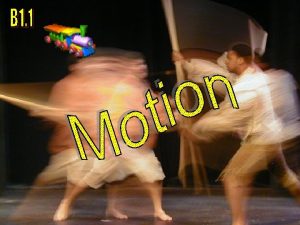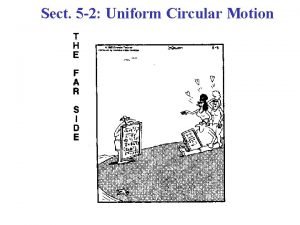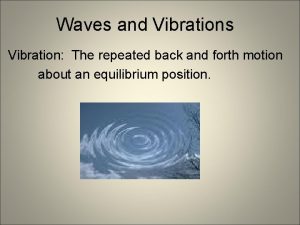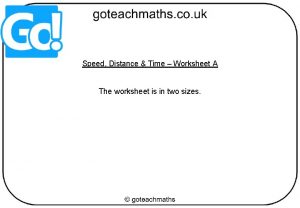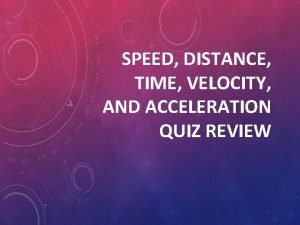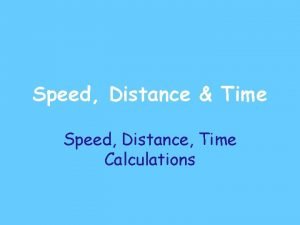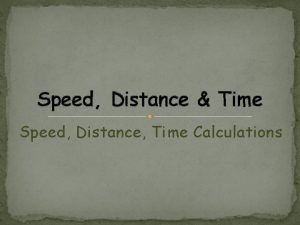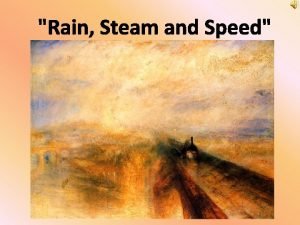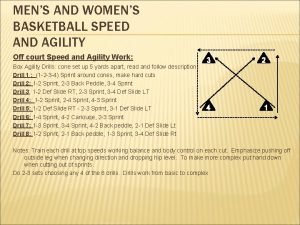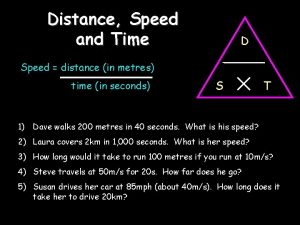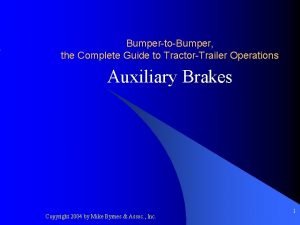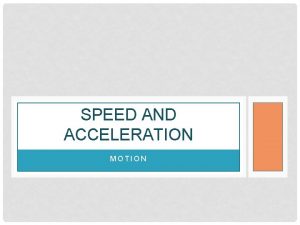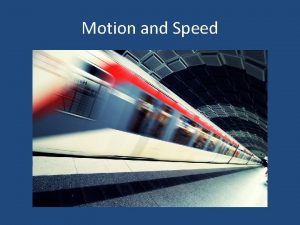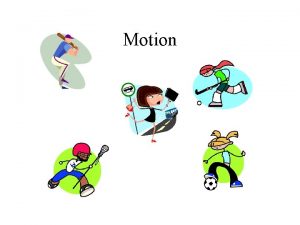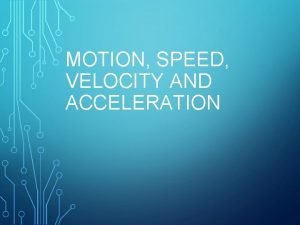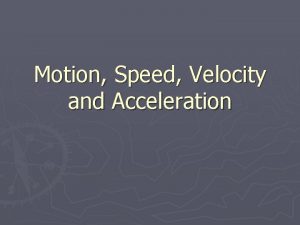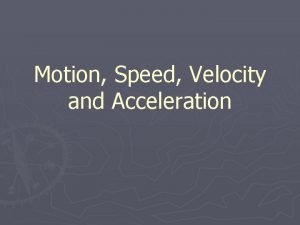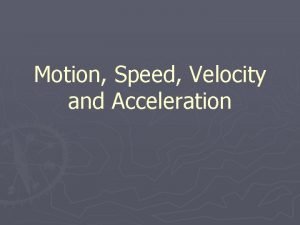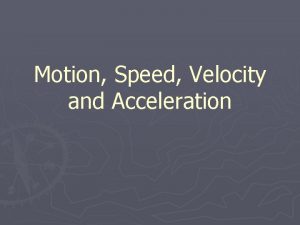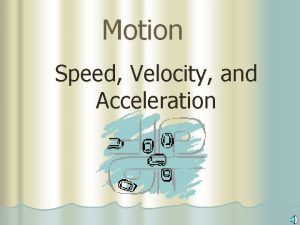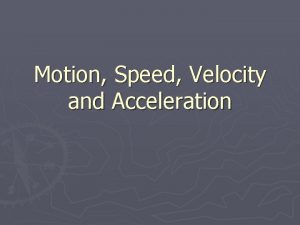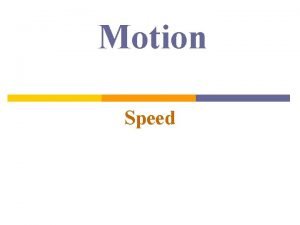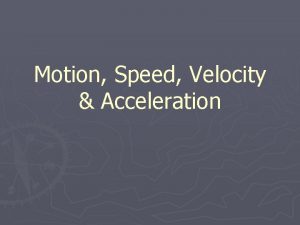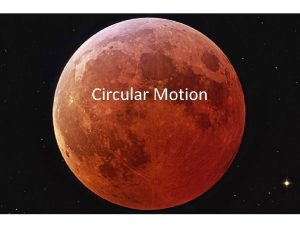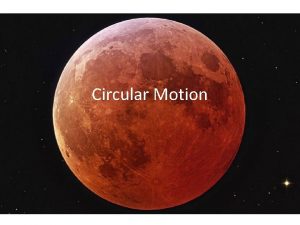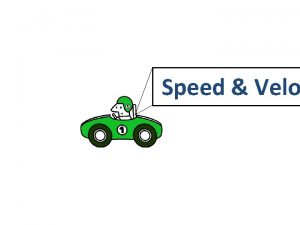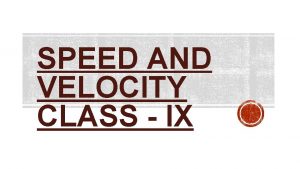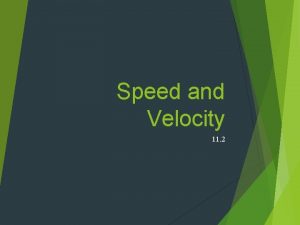Motion Part 1 Motion and Speed Speed is








































- Slides: 40

Motion Part 1: Motion and Speed

Speed is the distance an object travels per unit of time. To calculate speed: Speed = Distance ÷ Time Distance is in meters (m) Time is in seconds (s) Speed is in meters per second (m/s)

Example 1 A snail takes 5. 0 s to crawl across the ruler. Speed ==Distance 0. 07 = 2. 0 m m/s ÷÷ 5. 0 Time s

Example 2 A car drives 250 m in one minute. Speed = Distance == 250 4. 17 m ÷m/s ÷ 60 Time s

Use the Formula Triangle! d s t To calculate speed: To calculate time: To calculate distance: s=d/t t=d/s d=sxt

Distance vs. Displacement Distance and displacement are different. Distance Displacement How far an object moves in total. The distance and direction an object moves from a starting position.

Distance vs. Displacement Jeffrey, my distance was 176 meters! I G BE N But Billy, your displacement was 1 meter! D EN

Distance vs. Displacement 90 ft. Distance = 90 ft. Displacement = 90 ft.

Distance vs. Displacement 90 ft. Distance = 180 ft. Displacement =127 ft.

Distance vs. Displacement 90 ft. Distance = 270 ft. Displacement = 90 ft.

Distance vs. Displacement 90 ft. Distance = 360 ft. 90 ft. Displacement = 0 ft.

Any Questions?

Motion Part 2: Distance-Time Graphs

Graphing Speed The motion of an object can be graphed. A distance-time graph shows the motion of a certain object in line graph form. Time is plotted on the horizontal (X) axis Distance is plotted on the vertical (Y) axis

Distance-Time Graphs Time (s) Distance (m) 0 0 1 2 2 4 3 6 4 8 5 8 6 8 7 8 8 8 9 12 10 16 The slope of a distance-time graph is the speed

Distance-Time Graphs S=D÷T =0÷ 4 = 0 m/s S=D÷T =8÷ 4 = 2 m/s S=D÷T =8÷ 2 = 4 m/s

Distance-Time Graphs Constant speed No speed (moving away) (moving closer) (standing still) (and faster!)

Interpreting a D-T Graph (1) Analysis: Distance (m) • The distance (m) stays the same as the time (s) increases Time (s) • Therefore, the object is at rest (not moving)

Interpreting a D-T Graph (2) Analysis: Distance (m) • The object is moving away from the reference point • The object is moving at a constant speed Time (s) • The object is moving quickly

Interpreting a D-T Graph (3) Analysis: Distance (m) • The object is moving towards the reference point • The object is moving at a constant speed Time (s) • The object is moving slowly

Interpreting a D-T Graph (4) Distance (m) Analysis: • In Part A, the object is moving away at a constant speed B A C Time (s) • In Part B, the object is at rest • In Part C, it is moving towards at constant speed

Any Questions?

Motion Part 3: Velocity and Acceleration

Review: Speed is the distance an object travels in a specific amount of time. To calculate speed: Speed = Distance ÷ Time Distance is in meters (m) Time is in seconds (s) Speed is in meters per second (m/s)

Velocity Sometimes, knowing the speed isn’t enough. For example, sailors must know the speed and direction their boat is travelling in. Velocity is a description of both speed and direction. e. g. a sailboat travelling at 20 kph in a SE direction

Velocity Sometimes, knowing the speed isn’t enough. For example, sailors must know the speed and direction their boat is travelling in. Velocity is an example of a vector, a quantity that has both magnitude and direction.

Acceleration Objects can speed up, slow down or change direction. Acceleration measures how much an object’s speed changes over a certain time. Acceleration can be: A change in speed A change in direction A change in speed & direction

Acceleration can be positive, negative or zero. Positive Acceleration Object speeds up Negative Acceleration Object slows down Zero Acceleration Constant or no speed

Acceleration Formula for acceleration: acceleration = change in velocity time a = Vfinal - Vinitial t Velocity: meters per seconds (m/s) Time: seconds (s) Acceleration: meters per second squared (m/s 2)

Example 1 A motorcycle’s velocity at the top of the hill is 11. 0 m/s. 4. 0 seconds later it reaches the bottom of the hill with a velocity of 20. 0 m/s. What is the acceleration of the motorcycle? a = Vfinal - Vinitial t a = 20. 0 m/s - 11. 0 m/s 4. 0 a = 9. 0 m/s 4. 0 a = 2. 25 m/s 2

Example 2 A speed skater just finished a race. After she crossed the finish line, she coasted to a complete stop. If her initial speed was 13. 0 m/s and her acceleration was 2. 9 m/s 2, how long did it take her to stop? a = Vfinal - Vinitial t - 2. 9 m/s 2 = 0. 0 m/s - 13. 0 m/s t t (- 2. 9) = - 13. 0 m/s t = - 13. 0 m/s / - 2. 9 t = 4. 5 s

Any Questions?

Motion Part 4: Speed-Time Graphs

Interpreting a D-T Graph (1) Analysis: Distance (m) • The distance (m) increasing as time (s) passes • The distance gets larger and larger with each second Time (s) • This shows (+) acceleration

Interpreting a D-T Graph (1) Analysis: Distance (m) • The distance (m) decreasing as time (s) passes • The distance gets smaller & smaller with each second Time (s) • This shows (-) acceleration

Interpreting a D-T Graph (3) Analysis: Distance (m) • The distance (m) from a reference point is increasing • It is increasing at a regular rate Time (s) • This shows (0) acceleration

Interpreting a D-T Graph (3) Analysis: Distance (m) • The object is moving towards the reference point • The object is moving at a constant speed Time (s) • The object is moving slowly

Interpreting a S-T Graph (4) Analysis: Speed (m/s) • The speed (m/s) is constant as time (s) passes • The object’s speed is not changing Time (s) • This shows (0) acceleration

Interpreting a S-T Graph (5) Analysis: Speed (m/s) • The speed (m/s) is increasing as time (s) passes • The object speed is changing Time (s) • This shows (+) acceleration

Any Questions?
 Distance formula speed time
Distance formula speed time Part bar
Part bar Passengers can help a driver better manage emotions by
Passengers can help a driver better manage emotions by Speed detection of moving vehicle using speed cameras
Speed detection of moving vehicle using speed cameras Part whole model subtraction
Part whole model subtraction Part to part ratio definition
Part to part ratio definition Part part whole
Part part whole Define technical description
Define technical description The phase of the moon you see depends on ______.
The phase of the moon you see depends on ______. Minitab adalah
Minitab adalah Range of motion definition
Range of motion definition Indicates that you can draw an imaginary line
Indicates that you can draw an imaginary line Centripetal force inward or outward
Centripetal force inward or outward Angular acceleration formula with radius
Angular acceleration formula with radius Chapter review motion part a vocabulary review answer key
Chapter review motion part a vocabulary review answer key Projectile motion formula
Projectile motion formula Simple harmonic motion equation of motion
Simple harmonic motion equation of motion An object in motion stays in motion
An object in motion stays in motion Chapter 2 section 1 describing motion answer key
Chapter 2 section 1 describing motion answer key What is acceleration
What is acceleration Section 1 describing motion
Section 1 describing motion Describing motion section 1 answer key
Describing motion section 1 answer key Motion section 1 describing motion
Motion section 1 describing motion An introduction to shakespeare and romeo and juliet part 1
An introduction to shakespeare and romeo and juliet part 1 Fixed function logic devices
Fixed function logic devices A repeated back and forth motion
A repeated back and forth motion Welding travel speed chart
Welding travel speed chart Time speed formula
Time speed formula Speed & distance formula
Speed & distance formula Calculating speed time and distance worksheet
Calculating speed time and distance worksheet Speed and velocity quiz
Speed and velocity quiz Speed distance time triangle
Speed distance time triangle Speed = distance/time units
Speed = distance/time units Speed velocity and acceleration problems
Speed velocity and acceleration problems Rain steam and speed analysis
Rain steam and speed analysis Motion in straight line formula
Motion in straight line formula Lane agility drill test
Lane agility drill test Speed distance time triange
Speed distance time triange How to calculate speed by distance and time
How to calculate speed by distance and time Graphs that compare distance and time are called
Graphs that compare distance and time are called Types of auxiliary brakes
Types of auxiliary brakes











